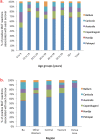Human Leptospirosis Infection in Fiji: An Eco-epidemiological Approach to Identifying Risk Factors and Environmental Drivers for Transmission
- PMID: 26820752
- PMCID: PMC4731082
- DOI: 10.1371/journal.pntd.0004405
Human Leptospirosis Infection in Fiji: An Eco-epidemiological Approach to Identifying Risk Factors and Environmental Drivers for Transmission
Abstract
Leptospirosis is an important zoonotic disease in the Pacific Islands. In Fiji, two successive cyclones and severe flooding in 2012 resulted in outbreaks with 576 reported cases and 7% case-fatality. We conducted a cross-sectional seroprevalence study and used an eco-epidemiological approach to characterize risk factors and drivers for human leptospirosis infection in Fiji, and aimed to provide an evidence base for improving the effectiveness of public health mitigation and intervention strategies. Antibodies indicative of previous or recent infection were found in 19.4% of 2152 participants (81 communities on the 3 main islands). Questionnaires and geographic information systems data were used to assess variables related to demographics, individual behaviour, contact with animals, socioeconomics, living conditions, land use, and the natural environment. On multivariable logistic regression analysis, variables associated with the presence of Leptospira antibodies included male gender (OR 1.55), iTaukei ethnicity (OR 3.51), living in villages (OR 1.64), lack of treated water at home (OR 1.52), working outdoors (1.64), living in rural areas (OR 1.43), high poverty rate (OR 1.74), living <100m from a major river (OR 1.41), pigs in the community (OR 1.54), high cattle density in the district (OR 1.04 per head/sqkm), and high maximum rainfall in the wettest month (OR 1.003 per mm). Risk factors and drivers for human leptospirosis infection in Fiji are complex and multifactorial, with environmental factors playing crucial roles. With global climate change, severe weather events and flooding are expected to intensify in the South Pacific. Population growth could also lead to more intensive livestock farming; and urbanization in developing countries is often associated with urban and peri-urban slums where diseases of poverty proliferate. Climate change, flooding, population growth, urbanization, poverty and agricultural intensification are important drivers of zoonotic disease transmission; these factors may independently, or potentially synergistically, lead to enhanced leptospirosis transmission in Fiji and other similar settings.
Conflict of interest statement
The authors have read the journal's policy and have the following conflicts. An employee of WHO was involved in study design and preparation of the manuscript.
Figures








Similar articles
-
Use of geographically weighted logistic regression to quantify spatial variation in the environmental and sociodemographic drivers of leptospirosis in Fiji: a modelling study.Lancet Planet Health. 2018 May;2(5):e223-e232. doi: 10.1016/S2542-5196(18)30066-4. Lancet Planet Health. 2018. PMID: 29709286 Free PMC article.
-
Predictive risk mapping of an environmentally-driven infectious disease using spatial Bayesian networks: A case study of leptospirosis in Fiji.PLoS Negl Trop Dis. 2018 Oct 11;12(10):e0006857. doi: 10.1371/journal.pntd.0006857. eCollection 2018 Oct. PLoS Negl Trop Dis. 2018. PMID: 30307936 Free PMC article.
-
Drivers of human Leptospira infection in the Pacific Islands: A systematic review.Epidemiol Infect. 2024 Oct 8;152:e118. doi: 10.1017/S0950268824001250. Epidemiol Infect. 2024. PMID: 39377125 Free PMC article.
-
Determinants of clinical leptospirosis in Nepal.Zoonoses Public Health. 2018 Dec;65(8):972-983. doi: 10.1111/zph.12516. Epub 2018 Aug 24. Zoonoses Public Health. 2018. PMID: 30144290
-
Climate change, flooding, urbanisation and leptospirosis: fuelling the fire?Trans R Soc Trop Med Hyg. 2010 Oct;104(10):631-8. doi: 10.1016/j.trstmh.2010.07.002. Epub 2010 Sep 1. Trans R Soc Trop Med Hyg. 2010. PMID: 20813388 Review.
Cited by
-
Estimating the duration of antibody positivity and likely time of Leptospira infection using data from a cross-sectional serological study in Fiji.PLoS Negl Trop Dis. 2022 Jun 13;16(6):e0010506. doi: 10.1371/journal.pntd.0010506. eCollection 2022 Jun. PLoS Negl Trop Dis. 2022. PMID: 35696427 Free PMC article.
-
Association of rodent-borne Leptospira spp. with urban environments in Malaysian Borneo.PLoS Negl Trop Dis. 2019 Feb 27;13(2):e0007141. doi: 10.1371/journal.pntd.0007141. eCollection 2019 Feb. PLoS Negl Trop Dis. 2019. PMID: 30811387 Free PMC article.
-
A cross-sectional seroepidemiological survey of typhoid fever in Fiji.PLoS Negl Trop Dis. 2017 Jul 20;11(7):e0005786. doi: 10.1371/journal.pntd.0005786. eCollection 2017 Jul. PLoS Negl Trop Dis. 2017. PMID: 28727726 Free PMC article.
-
An Observational Study of Human Leptospirosis in Seychelles.Am J Trop Med Hyg. 2020 Sep;103(3):999-1008. doi: 10.4269/ajtmh.19-0228. Am J Trop Med Hyg. 2020. PMID: 32700658 Free PMC article.
-
Prospective study of canine leptospirosis in shelter and stray dog populations: Identification of chronic carriers and different Leptospira species infecting dogs.PLoS One. 2018 Jul 11;13(7):e0200384. doi: 10.1371/journal.pone.0200384. eCollection 2018. PLoS One. 2018. PMID: 29995963 Free PMC article.
References
-
- Berlioz-Arthaud A, Kiedrzynski T, Singh N, Yvon JF, Roualen G, et al. Multicentre Survey of Incidence and Public Health Impact of Leptospirosis in the Western Pacific. Trans R Soc Trop Med Hyg. 2007;101: 714–721. - PubMed
Publication types
MeSH terms
Substances
Grants and funding
LinkOut - more resources
Full Text Sources
Other Literature Sources
Medical

